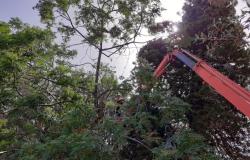
At the crossroads between three provinces (Parma, Piacenza and Cremona), and two regions (Emilia Romagna and Lombardy) there is a place where, for some years, Benedictine spirituality has taken root. The place is Vidalenzoa hamlet of the Parma municipality of Polesine Zibello: a group of houses that grew up in the shadow of the bell tower, as happens in many villages of our vast and fertile plain, inhabited by hard-working and tenacious people.
A place rich in history, just think that it was the birthplace of the greatest Verdi tenor of all time, maestro Carlo Bergonzi (whose birth centenary is on this occasion) who, despite having toured all over the world and having performed in the most famous theaters around the globe, he chose to return to “his” Vidalenzo, to rest in the small cemetery together with his family but also a stone’s throw from the chapel where Carlo Verdi and Luigia Uttini, Maestro Verdi’s parents, rest. A story also made of monasticism; in fact the small church of Santa Franca, located at the foot of the main embankment (subsidiary of the parish church) was founded in the 13th century by the Cistercian monks of the nearby Chiaravalle della Colomba Abbey. In the 17th century, and until the Napoleonic suppression of the religious orders, the same church was instead officiated by a small community of Franciscan friars. Now, a few years ago, Benedictine monks have arrived in Vidalenzo, with a small but lively community called “Guardians of Divine Love”who in the lands of the river have been able to create, in a short time, a true oasis of silence, spirituality and prayer that also looks to nearby towns, without distinctions of provinces or regions.
Here, only a few months ago, thanks to a happy intuition of the Cremonese journalist and writer Roberto FiorentiniDante returned to make his words heard through the voice of another Cremonese, the actor Massimo Pegorini. On that occasion, in the beautiful church dedicated to Saint Christopher, the verses of the XXXIII canto of the Paradise of the Divine Comedy resonated: as part of the meeting “Dante at the Hermitage”. An evening in which, with the participation of the monks themselves, religious meditation and listening to the absolute masterpiece of Italian literature were intertwined. It is right to remember that the Saint Bernard to whom Dante expresses his supplication to the Virgin so that he as a traveler can contemplate the Christian Trinity placed at the center of the Empyrean where the last act of the poet’s journey into the afterlife takes place, comes from the Benedictine family. Now, in the same church, until June 18, the splendid flowered carpet can be visited, a beautiful work of art and faith, desired and created on the occasion of the feast of Corpus Domini by the monks and parishioners. An artistic carpet which, in its fourth edition, is a journey through the most significant moments of the Church, celebrating the annual theme with a dedication that transcends art. Peter’s call, a turning point in Christian history, is depicted with a mastery that invites reflection. The flowers and seeds intertwine to form the image of a man who abandons his network to follow a greater calling, a gesture of pure faith that still resonates in the hearts of the faithful today. Continuing along the path, the carpet reveals the scene of the Last Supper, where Jesus breaks the bread, prefiguring the imminent sacrifice. Every detail is treated with reverence, every flower is a prayer, and the broken bread becomes a universal symbol of communion and sharing. At the center of this masterpiece, stands Saint Christopher the martyr, to whom the parish church is dedicated, the gentle giant who, according to legend, carried Jesus on his shoulder across a rushing river. His figure is a reminder of the strength and courage needed to bring the light of Christ into the world, a message that the parishioners of Vidalenzo wanted to enhance with every flower on their carpet. Finally, the carpet ends with a powerful image: the world supported by the cross, symbol of the universal Church. It is a reminder that, despite challenges and tribulations, faith has the power to unite and sustain communities through the ages.
“This work of art, created with passion and dedication, is an invitation to contemplate the beauty of faith – explain the monks of Vidalenzo – which manifests itself in tangible forms. It is a tribute to tradition, a bridge between past and present, and a message of hope for the future. The Benedictine monks and parishioners of Vidalenzo wish to give visitors not only a carpet, but a testimony of their inextinguishable faith”. The flower carpet is open to the public until 18 June (every day from 8.30am to 7pm) and is enriched by a further carpet created, for the first time, also in the church of Santa Franca, a place that has already fully breathed, since its foundation, monastic spirituality. But it’s not over because on Sunday, June 9th, in the rooms of the San Benedetto guesthouse, visitors will be able to visit two exhibitions: the art one by the Fidentian painter Ivana Bianchi and the one dedicated to the great Verdi tenor Carlo Bergonzi, created and curated by Gianluca Gotti . “These exhibitions – explain the monks – oThey offer an additional dimension of art and culture, enriching the spiritual experience with artistic expression.
This prayer corner in Vidalenzo is a shining example of how art, spirituality and community can converge to create a place of peace, reflection and beauty. It is a place where art is not just an aesthetic expression, but a means to express and experience connection with the divine. We invite everyone – they conclude – to visit and experience the tranquility and inspiration that this place has to offer. Whether it is through admiring the artistic carpet, participating in the liturgy, or listening to classical music, there is something for everyone in this corner of prayer”.
Finally, for lovers of Cremonese history, it should be remembered that Vidalenzo was an ancient rectorate of the diocese of Cremona and one of its parish priests, Oddone, is mentioned by Campi in his “Ecclesiastical history of Piacenza” as an intermediary in a border dispute that occurred in 1180 between the bishops of Cremona and Piacenza. Finally, the most important painting that the church of Vidalenzo possesses is an oil on canvas by Vincenzo Campi from Cremona which depicts “Christ deposed and two angels”. The work, which dates back to 1573, according to a study carried out by Professor Giovanni Godi, would be a faithful replica, even in size, of the painting of the same name kept in the parish church of Bordolano and, originally, it would have been kept in the church of San Mattia in Cremona .
(in the photos the flower display of Vidalenzo and that of Santa Franca)
Hermit of the Po




